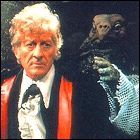 The Doctor and Jo pay a visit to the Master, who has been languishing in an isolated top-security prison since he was arrested by U.N.I.T. But in reality, the Master has already gained control of his jailkeepers, and is simply biding his time as he constructs a device that will summon the Sea Devils, a species of bipedal Earth reptiles related to the Silurians, who once walked the Earth before man. The Sea Devils have already been attacking ships at sea, but the Master has promised them the means to revive all of their people and regain their position as the rulers of Earth – even if it means eliminating the human race. As the Doctor tries to intervene, suggesting a peace between man and reptile, he finds himself fighting not only the Master, but the warlike impulses of homo sapiens.
The Doctor and Jo pay a visit to the Master, who has been languishing in an isolated top-security prison since he was arrested by U.N.I.T. But in reality, the Master has already gained control of his jailkeepers, and is simply biding his time as he constructs a device that will summon the Sea Devils, a species of bipedal Earth reptiles related to the Silurians, who once walked the Earth before man. The Sea Devils have already been attacking ships at sea, but the Master has promised them the means to revive all of their people and regain their position as the rulers of Earth – even if it means eliminating the human race. As the Doctor tries to intervene, suggesting a peace between man and reptile, he finds himself fighting not only the Master, but the warlike impulses of homo sapiens.
written by Malcolm Hulke
directed by Michael Briant
music by Malcolm ClarkeGuest Cast: Roger Delgado (The Master), Clive Morton (Trenchard), Royston Tickner (Robbins), Edwin Richfield (Hart), Alec Wallis (Bowman), Neil Seiler (Radio Operator), Terry Walsh (Barclay), Brian Justice (Wilson), June Murphy (Jane Blythe), Hugh Futcher (Hickman), Declan Mulholland (Clark), Pat Gorman, Brian Nolan, Steven Ismay, Frank Seton, Jeff Witherick (Sea Devils), Eric Mason (Smedley), Donald Sumpter (Ridgway), Stanley McGeagh (Drew), David Griffin (Mithcell), Christopher Wray (Lovell), Colin Bell (Summers), Brian Vaughn (Watts), Martin Boddey (Walker), Norman Atkyns (Rear Admiral), Rex Rowland (Girton), John Caesar (Myers), Peter Forbes-Robertson (Chief Sea Devil)
Broadcast from February 26 through April 1, 1972
LogBook entry & review by Earl Green
Review: One of those rare beasts – a six-parter which actually needed most of that airtime to tell its story – The Sea Devils is an effective sequel to 1970’s Doctor Who and the Silurians. It treads over much of the same ground in terms of the story, but manages to get more action and production value out of it as well. The various hovercraft and jet-ski scenes are well-done, even though filming conditions weren’t ideal – it’s easy to see that the sea was really quite restless.
This story could well be Roger Delgado’s most vicious portrayal of the Master, who normally pulls strings from the sidelines. But in this case, the Master is forced into more hand-to-hand fights, at one point drawing a gun and then engaging in a swordfight with the Doctor, one of the only times that the Master and the Doctor grappled physically in the 70s. At the same time, Delgado also plays up the humility very well in the early scenes where the audience is meant to consider him a prisoner. Additionally, numerous fellow cast members have singled Delgado out for praise in this episode, for refusing to use a stunt double in the jet-ski chase with the Doctor; Delgado was reportedly afraid of water, so taking to the open sea must have been a tremendous challenge for him.
 On the downside, there’s Malcolm Clarke‘s avant-garde synthesized music, which delves further into abstraction than most Doctor Who music. Think of Jerry Goldsmith‘s music from Logan’s Run – and then crank up the weird knob all the way to 10. There’s also the amusing government bureaucrat character who is more than willing to start a war from behind a desk, but cowers under the desk when the Sea Devils bring the fight to his office. And finally, late in the story, the Doctor leaves the Master under the guard of a lone armed sailor, who is of course quickly overcome. Surely the Doctor should’ve anticipated that rather than leave a helpless stranger to – more than likely – be killed by the Master?
On the downside, there’s Malcolm Clarke‘s avant-garde synthesized music, which delves further into abstraction than most Doctor Who music. Think of Jerry Goldsmith‘s music from Logan’s Run – and then crank up the weird knob all the way to 10. There’s also the amusing government bureaucrat character who is more than willing to start a war from behind a desk, but cowers under the desk when the Sea Devils bring the fight to his office. And finally, late in the story, the Doctor leaves the Master under the guard of a lone armed sailor, who is of course quickly overcome. Surely the Doctor should’ve anticipated that rather than leave a helpless stranger to – more than likely – be killed by the Master?
